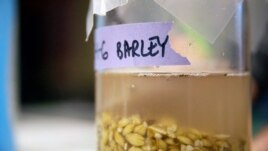Most college students would love to get an assignment like the one Madeline Ota recently received at Stanford University.
大多数大学生都会喜欢像斯坦福的麦德琳·奥塔(Madeline Ota)这样的作业。
She and her classmates were asked to make beer in their dorm rooms.
她和她的室友被要求在宿舍里酿造啤酒。
But before you get too excited, you need to know that it was for a class called The Archaeology of Food. And the assignment was to make beer according to a 5,000-year-old Chinese recipe.
但是在你过于兴奋之前,你需要知道,这是一堂《食物考古学》课程的要求。这项任务是根据一种五千年前的中国配方酿造啤酒。
"I think it was a bit different than beers that you would buy in the store because it only had a week to ferment, and I think that is one of the biggest differences that you would notice in taste. Because after only a week, alcoholic content isn't very strong."
“我认为它和商店中买到的啤酒有点不同,因为它只经过了1个星期的发酵。我认为这是你在味道上会注意到的最大的区别之一。因为只经过一个星期,酒精含量不是很高。”
Ota and her classmates made two kinds of ancient beer, some of which are still being made by indigenous people today. One of the beers was made by grinding grains like wheat, millet or barley.
奥塔和她的同学们酿造了两种古老的啤酒,有些啤酒现在土著人还在酿造。其中一种啤酒是通过小麦、小米或大麦之类的碾磨谷物酿造的。
The other was made using a root known as manioc, or cassava, in different parts of the world. The students chewed the root and then spit it into glass containers. Their saliva began the fermentation process.
另一种啤酒使用了木薯根。学生们把根嚼碎,然后吐到玻璃容器里。他们的唾液会开始发酵过程。
Water and heat were carefully added to each mixture.
每种混合物中都小心地加入了水和热量。
Ota said she has a new appreciation for what goes into making the beer people buy at stores or at the local bar.
奥塔表示,她对人们在商店或酒吧中购买的啤酒的酿造成分有了新的认识。
"This is not something we should take for granted when we go and pick up something from the store. And you know, that doesn't just apply to beer, but kind of any sort of processed food. There is a whole story behind how this got to where it is, how people produced it, how they cooked it..."
“这不是当我们走进商店拿起一些商品时想当然的一些事情,而且这不仅仅适用于啤酒,而是适用于任何加工食品。它是怎么来的,人们如何生产它,如何烹煮它,这背后有一个完整的故事。”
Their professor, Li Liu, discovered the old Chinese recipe.
他们的教授刘莉发现了这种古老的中国配方。
Liu and a graduate student, Jiajing Wang, "reverse engineered" their beer recipe based on substances found in clay pots from northeast China. That means they studied the residue and made guesses as to what the original ingredients might have been.
刘教授和她的研究生王佳静根据中国西北地区发现的瓦罐里的物质“逆向工程”得到了这个的配方。也就是说,他们研究了残留物质,并且推测出原始成分可能是什么。(51VOA注:该配方是在西安东郊米家崖遗址发现的,属于中国西北地区,老美搞错了方向。)
The researchers found evidence of barley, an important grain in making beer today. Until Liu and Wang did their research, most historians thought barley arrived in China more recently.
研究人员发现了大麦的证据。大麦是如今酿造啤酒的重要作物。大多数历史学家认为大麦是更晚传到中国,直到刘教授和王佳静做了这项研究。
"Again, that's where experimental archaeology comes in. Because when you have this small residue from an archaeological artifact, you know, you don't have the full story. You may have parts of a bigger story, but you don't know how those parts necessarily fit together. So experimental archaeology is really cool because it allows you to experiment with those processes and see which ones are the most successful."
“再说一次,这是实验考古学的结论。因为当你从考古器件上获得少数残留物质,你并不知道完整的故事。你可能知道了部分情节,但你并不知道这些情节如何匹配到一块。所以实验考古学真的很酷,因为它能让你试验这些过程,看看哪些最有效。”
Ota said we can learn a lot about ancient cultures by learning about their food and beer.
奥塔表示,我们能够通过了解他们的食物和啤酒,学习到很多古代文化。
"You know, when the first people started actually having farms and agricultural societies, very soon after that they actually started making the first alcohols using various techniques. Having alcohol became a very culturally significant and religious experience for many communities and it went on to become an important part of their society."
“你知道,当第一批人开始真正拥有农场和农业社会时,他们很快就开始利用各种技术酿造最初的酒。对很多社区来说,酒已经成为一种非常具有文化意义和宗教体验的东西,而且它还成为了他们社会的一个重要部分。”
Because the class treated the beer making like a science project, they were able to add their information to the scientific record. Every ingredient was carefully measured. Every degree of heat was noted.
由于该课程把酿造啤酒视为一种科学项目,他们得以把他们的信息添加到科学记录中。他们仔细测量了每种成分,记录了每种热度。
Thanks to the students, there is now a very specific record for how to make these ancient beers. In the past, the instructions might have been "fill the pot with water," Ota said. But no one ever knew how big the pot was or how much water was used.
感谢这些学生,如何酿造这些古老的啤酒如今有了一个非常具体的记录。奥塔表示,以前的说明书可能是“把水倒进锅里。”但是没人知道锅有多大,要用多少水。
But the most important question is: How did the beer taste?
但是最重要的问题是:这种啤酒味道如何?
The beer made from grain, Ota said, was fruity, like a cider. The one from manioc root smelled so bad – like cheese – she didn't want to try it.
奥塔表示,用谷物酿造的啤酒是水果味的,像苹果酒一样。木薯根酿造的啤酒很难闻,像是奶酪,她不想尝它的味道。
I'm Dan Friedell.
我是丹·费里德尔。(51VOA.COM对本文翻译保留全部权利,未经授权请勿转载,违者必究!)
By Dan Friedell19 February, 2017
Most college students would love to get an assignment like the one Madeline Ota recently received at Stanford University.
She and her classmates were asked to make beer in their dorm rooms.
But before you get too excited, you need to know that it was for a class called The Archaeology of Food. And the assignment was to make beer according to a 5,000-year-old Chinese recipe.
"I think it was a bit different than beers that you would buy in the store because it only had a week to ferment, and I think that is one of the biggest differences that you would notice in taste. Because after only a week, alcoholic content isn't very strong."
Ota and her classmates made two kinds of ancient beer, some of which are still being made by indigenous people today. One of the beers was made by grinding grains like wheat, millet or barley.
The other was made using a root known as manioc, or cassava, in different parts of the world. The students chewed the root and then spit it into glass containers. Their saliva began the fermentation process.
Water and heat were carefully added to each mixture.
Ota said she has a new appreciation for what goes into making the beer people buy at stores or at the local bar.
"This is not something we should take for granted when we go and pick up something from the store. And you know, that doesn't just apply to beer, but kind of any sort of processed food. There is a whole story behind how this got to where it is, how people produced it, how they cooked it..."
Their professor, Li Liu, discovered the old Chinese recipe.
Liu and a graduate student, Jiajing Wang, "reverse engineered" their beer recipe based on substances found in clay pots from northeast China. That means they studied the residue and made guesses as to what the original ingredients might have been.
The researchers found evidence of barley, an important grain in making beer today. Until Liu and Wang did their research, most historians thought barley arrived in China more recently.
 A close-up shot of the beer Stanford students recently made following an ancient Chinese recipe.
A close-up shot of the beer Stanford students recently made following an ancient Chinese recipe."Again, that's where experimental archaeology comes in. Because when you have this small residue from an archaeological artifact, you know, you don't have the full story. You may have parts of a bigger story, but you don't know how those parts necessarily fit together. So experimental archaeology is really cool because it allows you to experiment with those processes and see which ones are the most successful."
Ota said we can learn a lot about ancient cultures by learning about their food and beer.
"You know, when the first people started actually having farms and agricultural societies, very soon after that they actually started making the first alcohols using various techniques. Having alcohol became a very culturally significant and religious experience for many communities and it went on to become an important part of their society."
Because the class treated the beer making like a science project, they were able to add their information to the scientific record. Every ingredient was carefully measured. Every degree of heat was noted.
Thanks to the students, there is now a very specific record for how to make these ancient beers. In the past, the instructions might have been "fill the pot with water," Ota said. But no one ever knew how big the pot was or how much water was used.
But the most important question is: How did the beer taste?
The beer made from grain, Ota said, was fruity, like a cider. The one from manioc root smelled so bad – like cheese – she didn't want to try it.
I'm Dan Friedell.
Dan Friedell wrote this story for Learning English. Hai Do was the editor.
Would you like to try to make the beer the students at Stanford made? We want to know. Write to us in the Comments Section or on 51VOA.COM.
Words in This Story
assignment– n. a job or duty that is given to someone : a task someone is required to do
dorm – n. a building on a school campus that has rooms where students can live
archaeology – n. a science that deals with past human life and activities by studying the bones, tools, etc., of ancient people
ferment – v. to go through a chemical change that results in the production of alcohol
take for granted – v. to fail to properly notice or appreciate (someone or something that is helpful or important to you)
residue – n. a usually small amount of something that remains after a process has been completed or a thing has been removed
artifact – n. a simple object (such as a tool or weapon) that was made by people in the past
cool – adj. often used to show approval in a general way
cider – n. an alcoholic drink made from apples
bar – n. a building or room where alcoholic drinks and sometimes food are served
reverse engineer – v. to study the parts of (something) to see how it was made and how it works so that you can make something that is like it













